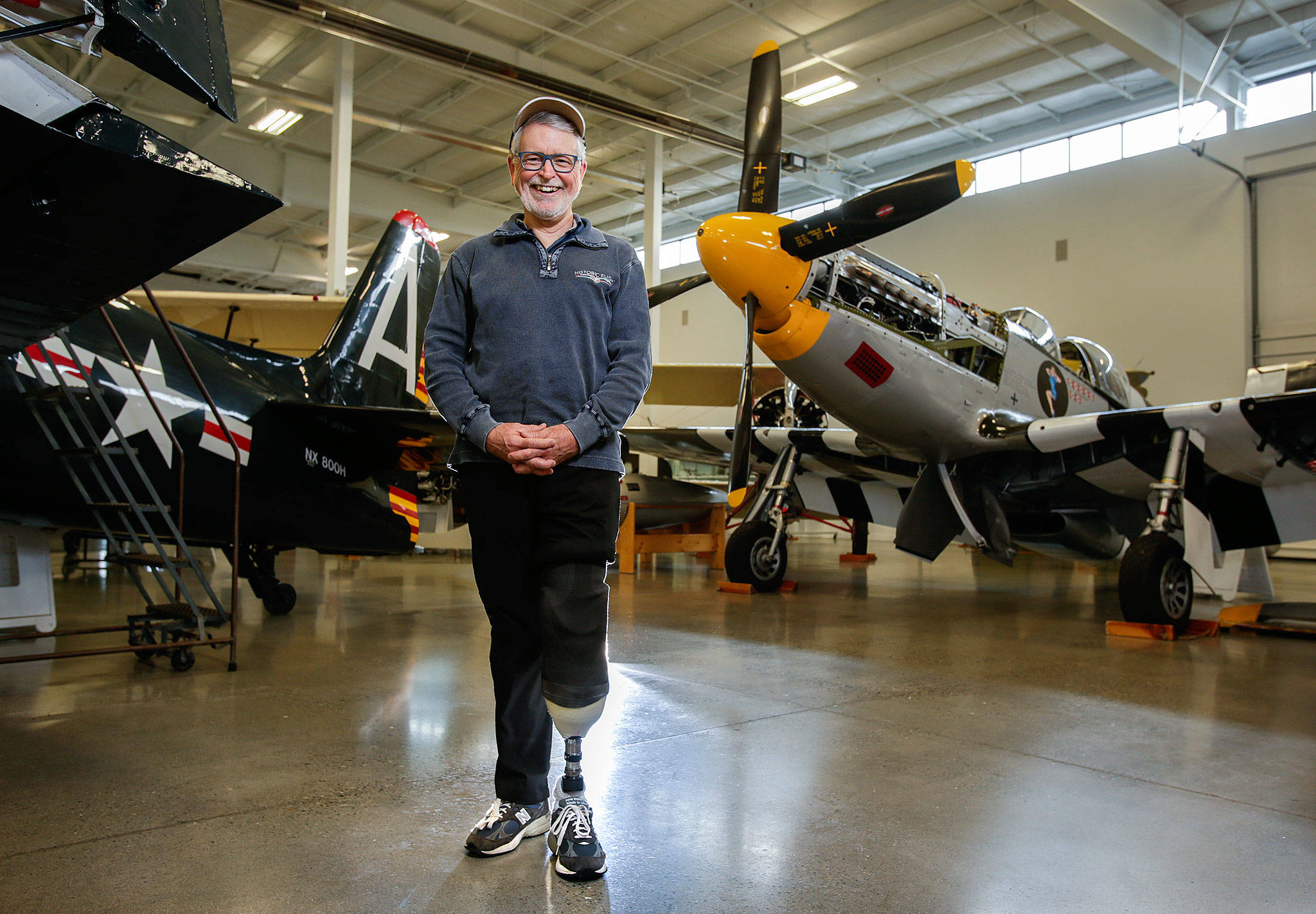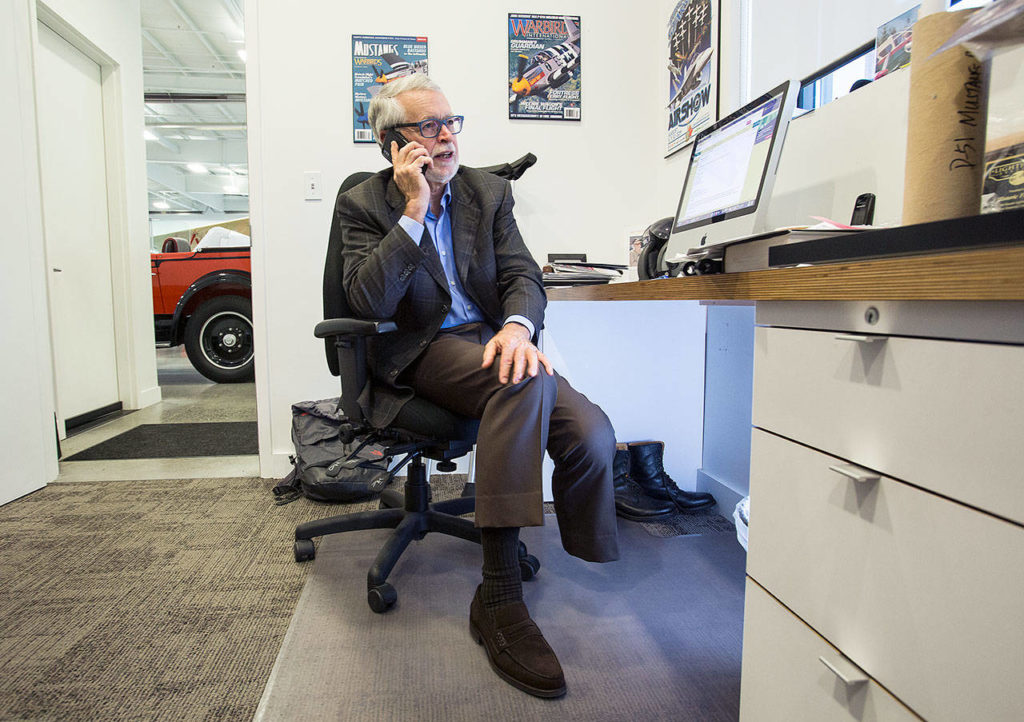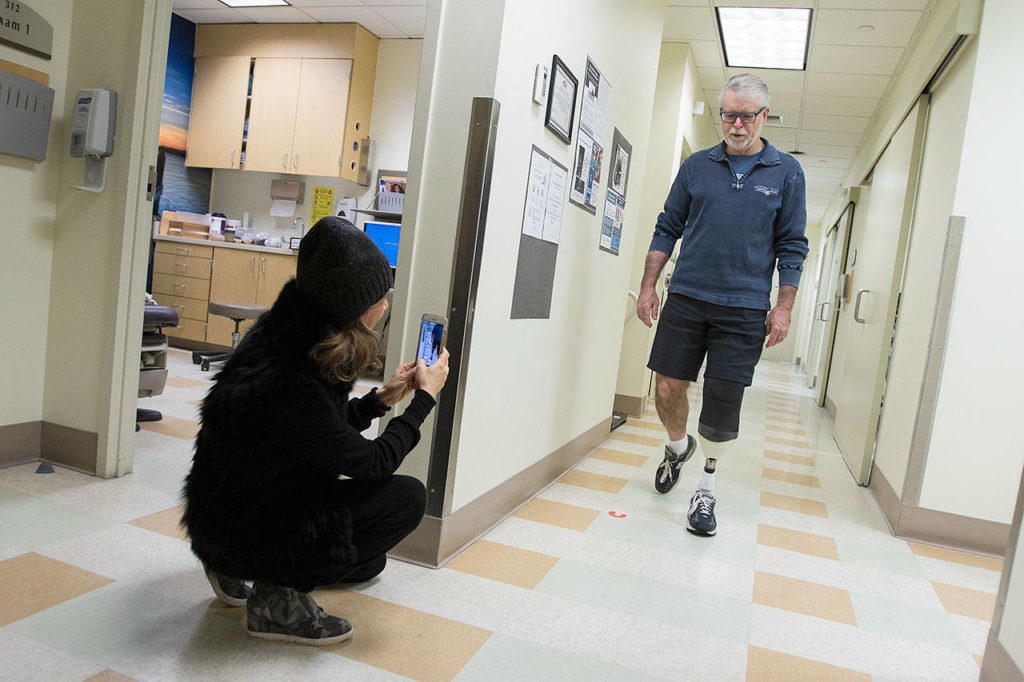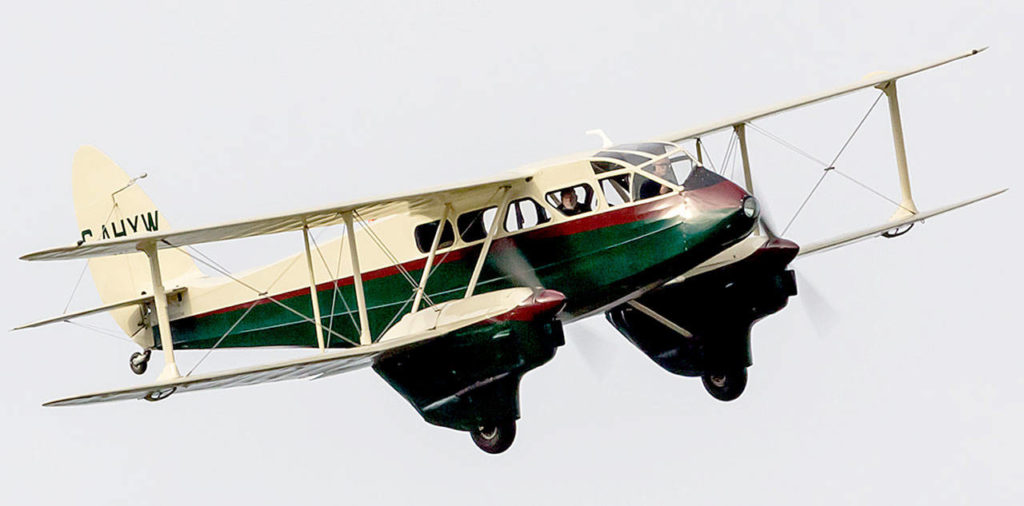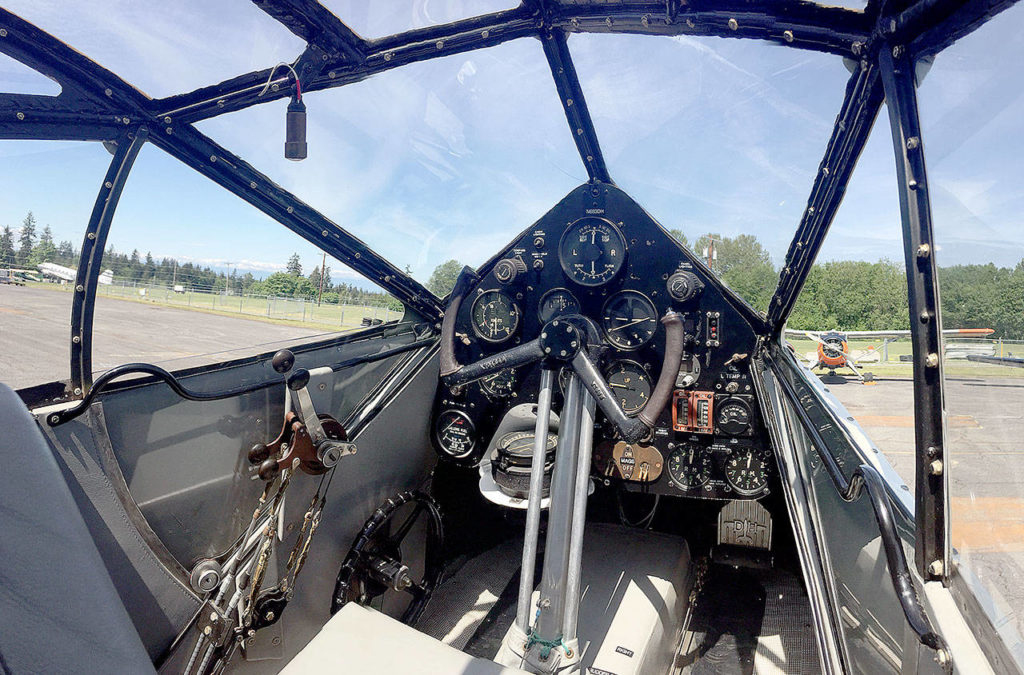MUKILTEO — John Sessions had barely coaxed the vintage biplane airborne when things started to go wrong.
The historic aircraft collector and pilot was taking four spectators on a scenic flight one Saturday afternoon in August, after the day’s main event at the Abbotsford International Airshow in British Columbia.
When Sessions taxied out, there had been a crosswind. The weather had been acting up earlier in the day. The conditions seemed like nothing, however, that the restored de Havilland Dragon Rapide and its pilot shouldn’t have been able to handle. He had flown another group in the rare 1930s airliner that morning and performed in a World War II-era fighter earlier in the afternoon.
This flight didn’t go so smoothly.
Once aloft in the biplane, Sessions began to lose control. He tried to keep it over the runway, as he attempted to gain airspeed.
“I went to the right, went to the left, it went to the right a second time and touched the right wing,” Sessions said. “When the right wing tip did touch, it whipped the nose down into the runway. It’s a one-pilot airplane. And the nose is made from wood and fabric, primarily, with a few metal strips between the panels of the windscreen. So I’m very lucky to be alive.”
A minute or less into flight, the immaculately restored Art Deco aircraft’s front end and right wing were crumpled. Sessions, the force behind the Historic Flight Foundation in Mukilteo, was critically hurt with a severed left foot. As he hopped from the wreckage, one of his passengers was unconscious.
Sitting directly behind Sessions was Larry Greschuk, then 73. Another man sat to his right, two others behind them.
An aviation enthusiast, Greschuk once owned an ultralight aircraft and was a former regular at the annual Abbotsford Airshow, widely considered among the best in the world. His daughter bought him tickets for 2018.
“My daughter knows me quite well,” said the soft-spoken power company retiree who lives on a farm 95 miles east of Edmonton, Alberta. “She knows that I don’t particularly like planes that were used for fighting and killing people, in other words, warbirds.”
She waited until the end of the show to give him something he’d cherish: a certificate to fly in Sessions’ biplane.
“Finally, I realized I was going to get to ride in this thing,” he said. “I was so impressed with the condition of the airplane. It was impeccable, so beautiful.”
The Dragon Rapide’s elegant lines evoke the end of one era of air travel, and the beginning of another. Its features, somewhere between sleek and rounded, look modern and stylishly antique at the same time.
The twin-engine aircraft debuted in the final days of planes made from wood and fabric. The British-built plane with room for eight marked the dawn of regularly scheduled commercial flights, though hardly convenient by today’s standards.
“It was used by the Empire to open up the far-flung countries,” Sessions said. It was the first plane to travel a route to Cape Town, South Africa, from London in the ’30s. That journey required 23 stops in 10 days.
The first de Havilland Dragon Rapide flew in 1934. Its creator, Geoffrey de Havilland, was a legendary aircraft designer whose company produced military and civilian aircraft, including the world’s first commercial jet airliner.
The Rapide’s wingspan is just shy of 50 feet. It was powered by four-cylinder engines on each side.
Production lasted a decade, with more than 700 made for civilian and military uses. Sessions bought his in 2017. Built for the Royal Air Force in 1944, that plane later went into civilian service with British European Airways, before seeing duty surveying major public works projects. It got shipped across the Atlantic in 1971 for display in the Experimental Aircraft Association Museum in Oshkosh, Wisconsin, and later wound up in California, as part of the private collection of William “Bud” Field, who died in 2010.
Sessions flew the newly acquired Dragon Rapide up the coast, though engine trouble forced him to leave it in Medford, Oregon, for extended repairs. Restoration finished in 2018, with a new silver and red paint scheme. It was, by Sessions’ estimate, one of only a dozen airworthy examples left in the world.
‘That sounds different … it’s wood breaking.’
During a brief pre-flight chat, Greschuk came away just as impressed with the pilot as with the airplane. He remembered Sessions politely correcting him about a type of vintage aircraft engine they’d heard earlier — what Greschuk took to be a Rolls-Royce Merlin was probably an Allison. The snippet of conversation was vintage Sessions: precise, measured and encyclopedic.
“I wished I could have spent a long time talking with him,” Greschuk said.
His ears relished the sounds once the old engines started up, rich and backfiring. As they taxied around, he took pictures from his seat on the left side of the aircraft.
A World War II-vintage torpedo bomber lined up before them and took off. They went right after.
When they first dipped to the right, Greschuk said it didn’t bother him much. Sessions corrected quickly. They got higher and the wing dipped to the left.
“I thought, well, something’s not quite right here.”
He looked right as they seemed to stall, an experience he knew all too well from the first time he flew his ultralight in the 1980s.
“When I saw the grass rushing up towards us, I knew we were in for a bit of a bang,” he said. “I heard the bang and I remember thinking, that sounds different … it’s wood breaking.”
“I must have had a bit of a nap because when I came to, the back seat was empty,” he said. “The passengers in the back, the two seats, they were gone.”
The man next to him was knocked out. Greschuk felt something trickling down his face: blood. On impact, his plastic sunglasses had cut a gash into his forehead.
“I thought, I ought to get out of here. This plane is wood. And there’s fuel. The best thing I can do is to get out of here.”
He crawled to the door and clambered down from the plane, with the help of a man on the ground. He saw firefighters walking toward the wreck.
Aside from his forehead and a bruised leg, he emerged in decent shape. At the hospital, they stitched him up, kept him overnight and gave him drugs to prevent a blood clot.
Sessions was in for a more complicated medical adventure.
The pilot stayed awake during the crash. The passenger in back of him, the one next to Greschuk, had been knocked out.
“I was doing what I could for him,” Sessions said. “He was pretty sleepy, pretty unconscious. I looked down and I saw that my foot was in the boot, totally separated from my leg. It had been snapped off. So I reached down and created pressure on the point of separation in my leg … minimizing the loss of blood.”
One of the back-seat passengers walked around to the front to hand Sessions a belt to use as a tourniquet. Emergency personnel started showing up, local crews as well as a flight surgeon for the Blue Angels, the U.S. Navy demonstration squadron, which was performing at the airshow. Sessions said the surgeon replaced the belt with a real tourniquet and tightened it to stop circulation below the knee.
“And so then I broke away what was left of the windscreen and I hopped out, still conscious,” he said. “They put me right on a gurney. I talked to the passengers. I was worried about them.”
During the crash, Sessions’ right arm had made contact with the runway. His right ankle got twisted, but popped back into place without breaking. He suspects his left leg got the worst of it because it was extended, and closer to the front of the airplane.
With the exception of the unconscious man, all of the passengers were up and walking.
“Your training kicks in when these sorts of things happen,” Sessions said. “It was, How are the passengers? Is everybody out? Is there any gas leaking? Is the electrical turned off? Yes, yes, yes, everything’s fine. No gas is leaking … It seems like everybody’s going to survive.”
Then, as the person most severely injured, it was time for him to get medical attention.
An investigation by the Transportation Safety Board of Canada is ongoing. Sessions, without making excuses, believes he simply didn’t have enough power to compensate for the wind conditions.
“What I learned that day, in this kite I was flying, is that there was no more power,” he said. “I had used it all to get to the takeoff. That’s just indicative of 1930s airplanes.”
At the crash scene in Abbotsford, medics kept talking to keep Sessions awake. They summoned a helicopter. On board, the adrenaline began to ebb.
“It was the first moment I could kind of relax a little, if you will,” he said.
A recovery, a setback and dark humor
The helicopter crew flew Sessions to the Royal Columbian Hospital in the Vancouver area, just over 30 miles to the west. It was the same medical center where his mother, a Canadian by birth, had trained to become an army nurse during World War II. She married his father, a patient who had served in the 101st Airborne Division and had been injured in Europe.
“So, when they said ‘Royal Columbian,’ I thought, well, maybe this is going to work out,” Sessions said.
Doctors performed a minor surgery that evening. They let him eat before another surgery the next morning. Volunteers from the Historic Flight Foundation scoured the neighborhood at night and came back with fish tacos.
When his wife, Lucia, arrived, he told her not to worry.
He said he would be alright and made some quips. One was that he was sure glad they had run with the bulls in Pamplona, Spain, that summer.
“With that, I finally got her to smile a little bit and relax,” he said.
He went into surgery the next morning, where they re-amputated the leg to create a base for a prosthesis. They had a short discussion about reattaching the foot. With the risk of infections and other complications, they decided against it.
“You’re better off to create a space for a modern prosthesis that will pretty much restore all of your functions of life,” he said.
Their treatment of the nerves above his stump helped keep him comfortable.
“As a consequence, I had very little pain,” Sessions said. “People who approach me about the accident are always very curious about the pain. ‘How did you stand the pain?’ I say, ‘Well, I didn’t feel any.’ Initially it was just adrenaline, y’know? When all that wore off, I give credit to the surgeons at Royal Columbian for knowing what they were doing and putting my leg back together in a way that would heal properly and not cause me serious discomfort.”
His two grown children arrived from Los Angeles as he recovered Sunday.
At 64, Sessions had lived his life without any extended hospital stays, aside from medical problems in infancy. He had stayed trim as a runner and outdoorsman. He was amazed, nevertheless, as his body, with help from his care team, started to knit itself back together.
By day three, the surgeon was already talking about getting Sessions to Seattle to start rehab. Around the same time, a British flying buddy, who also founded an aviation museum, called with an unusual offer: Would he like a prosthetic leg on loan? Not just any artificial leg, but one that was used by Sir Douglas Bader, a British national hero who flew combat missions for the Royal Air Force in World War II despite having lost both of his legs in an earlier flying accident. Sessions’ friend was offering one of Bader’s legs on display in his museum.
“I thought about it overnight and said, ‘That’s an English treasure that needs to stay in England, but please send me a picture so I can put it in my training room,’” Sessions said. “That’s what I did.”
Around 3 a.m. Wednesday, he was released for an ambulance ride to Harborview Medical Center in downtown Seattle.
Sessions had been impressed with the Canadian health-care providers, as he would be stateside. But on arrival, he first had to navigate some bureaucracy.
He told staff at Harborview he wanted to go to the amputation clinic for a cast to cover his wound.
“And they said, ‘Oh, there’s a problem here,’” he remembered. “’You know, the amputation clinic, to participate in that, requires you to be outpatient. You are inpatient. You’re a hospital patient.’ I said, ‘What, is this a billing-code issue?’”
“’Well, yeah, they can’t bill unless you’re outpatient,’” they informed him.
To be designated an outpatient, he could go to the end of a hall with a walker, then make it up and down 10 stairs with crutches. He muttered to himself.
“And I said, ‘Well, OK. Where’s the walker and the crutches? Show me how with the crutches to do stairs.’ So I did all that. So they released me.”
He went to the amputation clinic, got his cast and had his first appointment. They sent him home.
“Ninety-two hours from critical to my own bed,” Sessions said. “The story’s not over, but at least on that day it was a good outcome.”
Scarier than crashing
He started weekly appointments, to check wounds and get fresh casts. He began to heal and looked forward to getting his prosthetic limb.
A setback over Labor Day weekend was scarier than the accident.
A stomach ulcer, likely the result of trauma and his post-accident regimen of baby aspirin, caused blood loss with extremely low blood pressure and made his heart race.
In retrospect, he had felt fatigued that day. His workout of push-ups and sit-ups was harder than normal.
“But I was not paying attention,” he said.
By the time he reached Harborview on Sunday morning, “my vital signs were not very vital,” as he put it.
“My recent detour from a lineal recovery introduced me to a new cast of heroes,” he wrote to friends later that week. “The trauma world is full of them. May you never meet them professionally, but take comfort knowing they are ready for you, 24/365.”
He looked forward to aviation events that month.
“It will be a new experience to attend without flying,” he told friends. “Absence makes the heart grow fonder.”
He awaited his prosthetic foot. A shortage of skin around the wound necessitated a skin graft, slowing his progress.
He got his temporary prosthetic foot in late November. It starts about mid-calf and includes a foot shaped remarkably similar to the right one.
“It goes over a carbon-fiber flex foot, so I’m transferring energy from heel to toe as I walk,” he said. “You can feel the springing action.”
Throughout his life, Sessions has established a pattern of over-achievement. His recovery has moved with the same kind of intensity that has propelled his career and his aviation hobby.
He grew up in Spokane. At 17, he headed to study in Los Angeles, where he would earn an undergraduate degree from Loyola Marymount University and a business degree from UCLA.
He later worked on Capitol Hill while attending Georgetown University Law School at night. He went to work for Perkins Coie briefly in Washington, D.C., before the law firm brought him to the Emerald City. He eventually started his own law practice, but his work in real estate development became his full-time pursuit. He remains heavily involved in projects around the Bakken oil fields in North Dakota and Montana. He used to fly his own jet there in two hours.
“But now I’m going two hours early to commercial flights that with connections take about 10 hours to get there,” he said. “Being wheeled about in airports. It’s humbling.”
His interest in flying started in 1983, when he accompanied a friend to Boeing Field in Seattle. Two decades later, he founded the Historic Flight Foundation. The nonprofit’s building on the west side of Paine Field in Everett opened to the public in 2010. It specializes in aircraft from 1927 to 1957, spanning Charles Lindbergh’s solo crossing of the Atlantic Ocean to the first test flight of the Boeing 707. All airplanes in the collection can fly, and before his crash, Sessions could pilot them all.
On the horizon
By early December, Sessions was strolling around the Historic Flight gallery with his temporary prosthesis. Once he got going, a casual observer might have been hard-pressed to notice any limp.
Sessions isn’t content stopping there. He’d like to resume jogging. When the time is right, he’s determined to fly again.
To pilot an aircraft, he’ll need to sense pressure on the foot — to manage the brakes. In a warbird, that’s more for turning than stopping, but still no trivial matter.
“So I’ll be very careful I can feel what I need to feel before I launch,” he said.
His first step will probably be hopping into a vintage trainer aircraft. He and a colleague can take it for a spin, just to taxi around without leaving the ground.
“There is an FAA protocol for amputees,” Sessions said. “So when I feel ready to be examined in a check ride, the FAA will send out a designated examiner, who will fly with me. Once that check ride is successfully completed, all my type ratings come back. So it’s not as if I have to do it again in each airplane. They will trust me to know when I’m right for a particular type.”
The Rapide? It will fly again, too, if Sessions has his way. He hopes to get it fully restored. It’s in storage now in British Columbia.
As he recovers, Sessions draws inspiration from the double-amputee flying ace Douglas Bader and others who have endured greater hardships than he has.
“That and also the elite members of the airshow community who have themselves survived crashes,” he said. “Many I didn’t know had been in crashes.”
Before agreeing to a newspaper interview, Sessions wanted to talk to all of his passengers from the crash.
He’s met with three of the four face to face. The unconscious man? He’s doing well, Sessions reports.
The only one he hasn’t met in person is Greschuk, due to his remote address.
The retiree was surprised to get the first email from the pilot soon after the collision. They have been trading messages.
“I was really shocked when he said that he had lost his left leg,” Greschuk said. “I wanted him to know that I don’t blame him or anything. I just feel sorry that this happened.”
He told Sessions he’d fly with him again.
“No problem whatsoever,” he said. “I’d love to do that.”
Noah Haglund: 425-339-3465; nhaglund@heraldnet.com. Twitter: @NWhaglund.
Talk to us
> Give us your news tips.
> Send us a letter to the editor.
> More Herald contact information.
